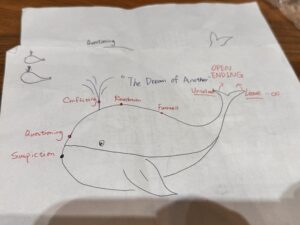Last month, I completed the Writing Speculative Fiction course and, today, I finished writing the first 2,500-word short story of my life.
I’ve always considered myself an idea person—my mind is constantly spinning with new plots and scenarios. Writing a full-length story has been on my bucket list for as long as I can remember. Back in primary and high school, I made several attempts to start writing novels, but my tendency to get overly satisfied with a strong opening meant I never managed to tie up the plot. Eventually, I’d abandon each project when the story became too hard to complete.
However, the two-day intensive course, combined with its practical exercises, gave me a solid framework for how to approach writing a complete story. During the class, the instructors used various techniques to help us brainstorm, and it was during one of these exercises that my story idea began to take shape.
One concept from the course that really struck me was “creating a premise that breaks the rules of reality.” Around that time, I had come across a story about a blogger who claimed to have fallen in love with ChatGPT. Interestingly, ChatGPT’s terms of use explicitly forbid users from attempting to form romantic relationships with it. That got me thinking—what if I built a story around this “taboo” idea? What if I wrote about a human falling in love with an AI?
My idea was further inspired by Detroit: Become Human, which I played last year. Coincidentally, the day I finished the game, GPT’s upgrade made headlines worldwide. Since then, I’ve often wondered what a future with AI fully integrated into our lives would look like. Would humans see AI as tools, pets, or even as family or romantic partners? Could AI truly feel emotions like humans, or would they just imitate us? If they could feel, would they be granted human rights, or would they remain “emotional slaves”? These questions fascinated me. With this “breaking societal norms” premise in mind, I decided to set my story in a future where AI is widespread and explore the question of whether AI with emotions deserves freedom.
After completing the course, I was eager to begin outlining my story. But writing a short story turned out to be far more challenging than I had imagined—especially with a futuristic setting. Creating a fictional background often requires extensive “hard worldbuilding,” which eats up a lot of word count. Since this would have left little room for the emotional “soft world” elements, I had to let go of detailed world descriptions, which made the story feel less rich than I’d hoped. If I get the chance to revisit this idea in the future, I’d love to write a full-length novel set in a fully fleshed-out world of my own creation.
One concept from the course that I found particularly useful was “The Shape of the Story.” By sketching out a visual outline of the story’s rises and falls—whether as a snake, a fish, or another shape—I was able to better organize my thoughts. As someone with a tendency for scattered and spontaneous ideas, this approach helped me lay out my creative logic quickly and clearly. I also learned how to make the most of limited word counts by balancing hard and soft worldbuilding with the right narrative perspective to make the story more compelling.
The Shape of The Story I made in the class
Finishing my very first short story felt incredible, almost like fulfilling a childhood dream. I’m gratefulfor the knowledge I gained in this course and hope to apply it in the future, turning all the creative ideas in my head into fully realized stories.

